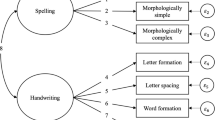Abstract
The purpose of this study was to compare the effects of Self-Correction and Traditional spelling on the acquisition, maintenance, and generalization of spelling words with five junior high school students with learning disabilities. During Traditional spelling students received a weekly list of 20 unknown words. Daily 20-minute assignments with these words varied among writing them, arranging them in alphabetical order, dividing the words into syllables, and using a dictionary to locate word meaning. Students were tested on the 20 words at the end of the week. During Self-Correction, students received 20 words on a 5-column sheet of paper. Columns were arranged so that stimulus words could be hidden by folding the paper back, and later exposed after the teacher dictated and the student wrote the words. Students used proofreading marks to self-correct. Sessions lasted 20 minutes, and weekly, delayed, and generalized assessments were conducted. Results indicated that for all five students the Self-Correction procedure was more effective for word acquisition than Traditional spelling. Also, for four of the five students, maintenance of words was higher under Self-Correction. Generalization occurred for three students. Finally, measures of social validity indicated that the students preferred Self-Correction over Traditional spelling, although two teachers in regular classrooms did not notice significant changes in the overall spelling performance for the students. Implications for the classroom practitioner are discussed.
Similar content being viewed by others
References
Allred, R. A. (1977).Spelling: The application of research findings. Washington, DC. The National Education Association.
Allred, R. A. (1984).What research says to the teacher: Spelling trends, contents and methods. Washington, D.C.: National Education Association.
Brigance, A. H. (1977).Brigance: Diagnostic inventory of basic skills. N. Billerica, MA: Curriculum Associates.
Carpenter, D., & Miller, L. J. (1982). Spelling ability of reading disabled LD students and able readers.Learning Disability Quarterly, 5, 65–70.
Christine, R., & Hollingsworth, P. (1966). An experiment in spelling.Education, 86, 565–567.
DeStefano, J. S. (1978).Language, the learner, and the school. New York: John Wiley.
Dunn, L. M., & Markwardt, F. C. (1970). PeabodyIndividual Achievement Test. Circle Pines, MN: American Guidance Service.
Fernald, G. (1943).Remedial techniques in basic school subjects. New York: McGraw-Hill.
Ganschow, L. (1983). Teaching strategies for spelling success.Academic Therapy, 19, 185–193.
Gillingham, A., & Stillman, B. (1970).Remedial training for children with specific difficulty in reading, spelling, and penmanship (7th ed.). Cambridge, MA: Educators Publishing Service.
Graham, S., & Miller, L. (1979). Spelling research and practice: A unified approach.Focus on Exceptional Children, 12, 1–16.
Hawkins, R. (1984). What is “meaningful” behavior change in a severely/profoundly retarded learner. In W. L. Heward, T. E. Heron, D. S. Hill, & J. Trap-Porter (Eds.),Focus on behavior analysis in education (pp. 282–286). Columbus, OH: Merrill.
Heron, T. E., Okyere, B., & Miller, A. (1991). A taxonomy of spelling approaches.Journal of Behavioral Education, 1, 117–130.
Horn, T. D. (1947). The effects of the corrected test on learning to spell.The Elementary School Journal, 47, 277–285.
Larsen, S., & Hammill, D. D. (1976).Test of Written Spelling. Austin, TX: Pro-Ed.
McNeish, J. (1985).Effects of self-correction on acquisition, maintenance, and generalization of spelling words with learning disabled students. Unpublished masters thesis, The Ohio State University, Columbus.
Schoephoerster, H. (1962). Research into variations of the test-study plan of teaching spelling.Elementary English, 39, 460–462.
Schoolfield, L., & Timberlake, J. (1960).The phonovisual method. Washington, DC: Phonovisual Products.
Tawney, J. W. (1984). Empirical verification of instruction: A realistic goal. In W. L. Heward, T. E. Heron, D. S. Hill, & J. Trap-Porter (Eds.),Focus on behavior analysis in education, (pp. 246–253). Columbus, OH: Merrill.
Wallace, G., Cohen, S. B., & Polloway, E. A. (1987).Language arts. Austin, TX: Pro-Ed.
Author information
Authors and Affiliations
Additional information
This manuscript is based on the masters thesis of the first author.
Rights and permissions
About this article
Cite this article
McNeish, J., Heron, T.E. & Okyere, B. Effects of self-correction on the spelling performance of junior high students with learning disabilities. J Behav Educ 2, 17–27 (1992). https://doi.org/10.1007/BF00947135
Accepted:
Issue Date:
DOI: https://doi.org/10.1007/BF00947135




